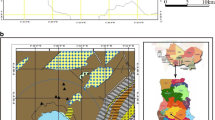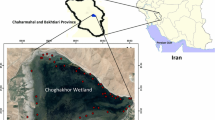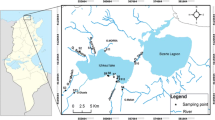Abstract
In this research, we study on the distribution of several elements in bed sediments of Anzali wetland. Anzali, one of the most important international wetlands, is located on the southern coast of the Caspian Sea in Iran. This wetland receives discharges of domestic, agricultural, and industrial wastewater, which affect the distribution of elements. Our contribution in this study is threefold. First, we measured the total concentration of metals as well as their chemical partitioning and bioavailability in the sediments. Second, we calculated anthropogenic portions of metals in the sediment of this area. The results reveal anthropogenic portion of metals as Mo > Mn > Cd > As > Zn > Hg > Co > Sn > Cu > V > Ag > Ni > Pb > Fe > Cr > Al, respectively. We evaluated the intensity of pollution by using an enrichment factor, the geo-accumulation index and the pollution index. All these indices do not take into consideration the bioavailability of the elements. As our third and most important contribution, we introduced a new formula that takes into account the bioavailability of different elements. In comparison with aforementioned pollution indices, our newly introduced pollution index has a higher Pearson correlation with anthropogenic portion of metals. This high-correlation coefficient shows that our proposed pollution index is an effective indicator for determining the level of pollution, while other indices preserve their own merits.




Similar content being viewed by others
References
Adekola, F.A., & Eletta, O.A.A. (2007). A study of heavy metal pollution of Asa River, Ilorin, Nigeria; trace metal monitoring and geochemistry. Environmental Monitoring and Assessment, 125, 157–163.
Adjei-Boateng, D., Obirikorang, K., Amisah, S. (2010). Bioaccumulation of heavy metals in the tissue of the clam Galatea paradoxa and sediments from the Volta Estuary, Ghana. International Journal of Environmental Research, 4(3), 533–540.
Ahmad, M., Islam, S., Rahman, S., Haque, M., Islam, M. (2010). Heavy metals in water, sediment and some fishes of Buriganga River, Bangladesh. International Journal of Environmental Research, 4(2), 321–332.
Allen, H.E. (1995). Metal contaminated aquatic sediments. Michigan: Ann Arbor Press.
Ankley, G., Di Toro, D., Hansen, D., Berry, W. (1996). Technical basis and proposal for deriving sediment quality criteria for metals. Environmental Toxicology and Chemistry, 15(12), 2056–2066.
Bidhendi, G.N., Karbassi, A., Nasrabadi, T., Hoveidi, H. (2007). Influence of copper mine on surface water quality. International Journal of Engineering Science and Technology, 4(1), 85–92.
Biney, C., Amuzu, A., Calamari, D., Kaba, N., Mborne, I., Naeve, H. (1994). Review of heavy metals in the african aquatic environment. Ecotoxicology and Environmental Safety, 28(2), 134–159.
Bowen, H.J. (1979). Environmental chemistry of the elements. London: Academic Press.
Chester, R., & Hughes, R. (1967). A chemical technique for the separation of ferro-manganese minerals, carbonate minerals and adsorbed trace elements from pelagic sediments. Chemical Geology, 2, 249–262.
Das, A., Chakraborty, R., Cervera, M., De la Guardia, M. (1995). Metal speciation in solid matrices. Talanta, 42(8), 1007–30.
Datta, D., & Subramanian, V. (1998). Distribution and fractionation of heavy metals in the surface sediments of the Ganges–Brahmaputra–Meghna River system in the Bengal Basin. Environmental Geology, 36(1–2), 93–101.
Davies, C., Tomlinson, K., Stephenson, T. (1991). Heavy metals in river tees estuary sediments. Environmental Technology, 12(11), 961–972.
Ehlers, L., & Luthy, R. (2003). Contaminant bioavailability in soil and sediment. Environmental Science and Technology, 37(15), 295A–302A.
Ehlke, S., & Kirchner, G. (2002). Environmental processes affecting plant root uptake of radioactive trace elements and variability of transfer factor data: a review. Journal of Environmental Radioactivity, 58(2–3), 97–112.
EPA. (1998). Environmental protection agency report . Washington: The Office of Water, EPA.
Everaat, J., & Fischer, C. (1992). The distribution of heavy metals (Cu, Zn, Cd, Pb) in the fine fraction of surface sediments of the North Sea. Netherlands Journal of Sea Research, 29(4), 323–331.
Fang, T., & Hong, E. (1999). Mechanisms influencing the spatial distribution of trace metals in surficial sediments off the South-Western Taiwan. Marine Pollution Bulletin, 38(11), 1026–1037.
Forstner, U., & Wittmann, G.T. (1981). Metal pollution in aquatic environment. Earth Sciences and Geography. Berlin: Springer.
Forstner, U., Ahlf, W., Calmano, W., Kersten, M. (1991). Sediment criteria development. Sediments and environmental geochemistry (pp. 311–338). Berlin: Springer.
Ghazban, F., & Zare Khosh Eghbal, M. (2010). Source of heavy metal pollutions in sediments of the Anzali Wetland in 25, Northern Iran. Journal of Environmental Studies, 37(1), 45–56.
Gibbs, R.J. (1973). Mechanisms of trace metal transport in rivers. Science, 180, 71–73.
Gonzalez, A., Rodriguez, M., Sanchez, J., Espinosa, A.J., De La Rosa, F.J. (2000). Assessment of metals in sediments in a tributary of Guadalquiver River (Spain). Heavy metal partitioning and relation between the water and sediment system. Water, Air, and Soil Pollution, 121(1–4), 11–29.
Heyvaert, A., Reuter, J., Slotton, D., Goldman, C. (2000). Paleolimnological reconstruction of historical atmospheric lead and mercury deposition at Lake Tahoe, California, Nevada. Environmental Science and Technology, 34(17), 3588–3597.
Horowitz, A., & Elrick, K. (1987). The relation of stream sediment surface area, grain size and composition to trace element chemistry. Applied Geochemistry, 2(4), 437–451.
Horowitz, A.J., Meybeck, M., Idlafkih, Z., Biger, F. (1999). Variations in trace element geochemistry in the Seine River basin based on floodplain deposits and bed sediments. Hydrological Processes, 13(9), 1329–1340.
Horsfall, M., & Spiff, A.I. (2002). Distribution and partitioning of trace metals in sediments of the lower reaches of the new Carlabar River, Port Harcourt, Nigeria. Environmental Monitoring and Assessment, 78, 309–326.
Jain, C.K., Singhal, D., Sharma, U.K. (2005). Metal pollution assessment of sediment and water in the river Hindon, Hindon, India. Environmental Monitoring and Assessment, 105, 193–207.
JICA (2004). The study on integrated management for ecosystem conservation of the Anzali Wetland. Tokyo: Nippon Koei Co, Ltd.
Jones, B., & Turki, A. (1997). Distribution and speciation of heavy metals in surficial sediments from the tees estuary, North-East England. Marine Pollution Bulletin, 34(10), 768–779.
Karageorgis, A.P., Sioulas, A.I., Anagnostou, C.L. (2001). Use of surface sediments in Pagassitikos Gulf, Greece, to detect anthropogenic influence. GeoMarine Letters, 21(4), 200–211.
Karbassi, A.R., & Amirnezhad, R. (2004). Geochemistry of heavy metals and sedimentation rate in a bay adjacent to the Caspian Sea. International Journal of Environmental Science and Technology, 1, 191–198.
Karbassi, A.R., Bayati, I., Moattar, F. (2006). Origin and chemical partitioning of heavy metals in riverbed sediments. International Journal of Engineering, Science and Technology, 3(1), 35–42.
Karbassi, A.R., Nouri, J., Ayaz, G.O. (2007). Flocculation of trace metals during mixing of Talar River water with Caspian seawater. International Journal of Environmental Research, 1(1), 66–73.
Karbassi, A.R., Monavari, S., Nabi Bidhendi, G., Nouri, J., Nematpour, K. (2008). Metal pollution assessment of sediment and water in the Shur River. Environmental Monitoring and Assess, 147(1–3), 107–116.
Kersten, M., & Forstner, U. (1991). Speciation of trace elements in sediments. Trace element speciation: analytical methods and problems. Boca Raton: CRC Press.
Klavins, M., Briede, A., Rodinov, V., Kokorite, I., Parele, E., Klavina, I. (2000). Heavy metals in rivers of Latvia. Science of The Total Environment, 262(1–2), 175–183.
Li, Y., Yu, Z., Song, X., Mu, Q. (2006). Trace metal concentrations in suspended particles, sediments and clams from Jiaozhou Bay of China. Environmental Monitoring and Assessment, 121, 491–501.
Lindsay, W.L., & Norvell, W.A. (1978). Development of a DTPA soil test for zinc, iron, manganese, and copper. Soil Science Society of America Journal, 42, 421–428.
Linnik, P.N. (2001). Bottom sediments of reservoirs as a potential source of secondary pollution of the aquatic environment by heavy metal compounds. Hydrobiological Journal, 37(1), 73–86.
Lopez-sancheza, J.F., Rubioa, R., Raureta, G. (1993). Comparison of two sequential extraction procedures for trace metal partitioning in sediments. International Journal of Environmental Analytical Chemistry, 51(1–4), 113–121.
Mehrdadi, N., Ghobadi, M., Nasrabadi, T., Hoveidi, H. (2006). Evaluating the qualitative condition and self purification potential of Tajan River using Qual2E model. Iranian Journal of Environmental Health, Science and Engineering, 3(3), 199–204.
Mileston (2003). Application field: Environment. Digestion note DG-EN-45, Mileston Co. http://www.milestonesrl.com/analytical/customer-care-library-digestion.html.
Moore, J., Brook, E., Johns, C. (1989). Grain size partitioning of metals in contaminated, coarse-grained river floodplain sediment: Clark Fork River, Montana, U.S.A. Environmental Geology and Water Sciences, 14(2), 107–115.
Morillo, J., & Usero, J. (2008). Trace metal bioavailability in the waters of two different habitats in Spain: Huelva Estuary and Algeciras Bay. Ecotoxicology and Environmental Safety, 71(3), 851–859.
Morillo, J., Usero, J., Gracia, I. (2002). Partitioning of metals in sediments from the Odiel River (Spain). Environment International, 28, 263–271.
Muller, G. (1979). Schwermetalle in Den Sediments Des Rheins-Veranderungen Seitt 1971. Umschan, 79, 778–783.
Nasrabadi, T., Nabi Bidhendi, G.R., Karbassi, A.R., Hoveidi, H., Nasrabadi, I., Pezeshk, H. (2009). Influence of Sungun copper mine on groundwater quality, NW Iran. Environmental Geology, 58(4), 693–700.
Nasrabadi, T., Nabi Bidhendi, G.R., Karbassi, A.R., Mehrdadi, N. (2010). Evaluating the efficiency of sediment metal pollution indices in interpreting the pollution of Haraz River sediments, Southern Caspian Sea basin. Environmental Monitoring and Assessment, 171, 395–410.
Opuene, K., Okafor, E., Agbozu, I.E. (2008). Partitioning characteristics of heavy metals in a non-tidal freshwater ecosystem. International Journal of Environmental Research, 2(2), 285–290.
Pekey, H. (2006). Heavy metal pollution assessment in sediments of the Izmit Bay, Turkey. Environmental Monitoring and Assessment, 123(1–3), 219–231.
Pourang, N. (1996). Heavy metal concentrations in surficial sediments and benthic macroinvertebrates from Anzali Wetland, Iran. Hydrobiologia, 331(1–3), 53–61.
Pourang, N., Richardson, C., Mortazavi, M. (2010). Heavy metal concentrations in the soft tissues of swan mussel (Anodonta cygnea) and surficial sediments from Anzali Wetland, Iran. Environmental Monitoring and Assessment, 163(1–4), 195–213.
Ranjbar, G.A. (1998). Heavy metal concentration in surficial sediments from Anzali Wetland, Iran. Water, Air, and Soil Pollution, 104(3–4), 305–312.
Rauret, G., Rubio, R., Lopez-Sanchez, J., Casassas, E. (1988). Determination and speciation of copper and lead in sediments of a Mediterranean River (River Tenes, Catalonia, Spain). Water Research, 22(4), 449–455.
Riahi, A., Fazeli, M., Paydar, M. (2004). Determination of heavy metal content in Astacus leptodactylus caspicus of Anzali Wetland, Iran. The Korean Journal of Ecology, 27(1), 15–20.
Rivail Da Silva, M., Lamotte, M., Donard, O. F., Soriano-Sierra, E., Robert, M. (1996). Metal contamination in surface sediments of mangroves, lagoons and Southern Bay in Florianopolis Island. Environmental Technology, 17(10), 1035–1046.
Sharma, V., Rhhudy, K., Koening, R., Vazquez, F. (1999). Metals in sediments of the upper Laguna Madre. Marine Pollution Bulletin, 38(12), 1221–1226.
Shresta, S., & Kazma, F. (2007). Assessment of surface water quality using multivariate statistical techniques: a case study of the Fuji River basin, Japan. Environmental Modelling and Software, 22(4).
Silva, S., Re, A., Pestana, P., Rodrigues, A., Quintino, V. (2004). Sediment disturbance off the Tagus Estuary, Western Portugal: chronic contamination, sewage outfall operation and runoff events. Marine Pollution Bulletin, 49(3).
Singh, M. (2001). Heavy metal pollution in freshly deposited sediments of the Yamuna River (the Ganges River tributary): a case study from Delhi and Agra Urban Centres, India. Environmental Geology, 6, 664–671.
Stamatis, N., Kamidis, N., Sylaios, G. (2006). Sediment and suspended matter lead contamination in the Gulf of Kavala, Greece. Environmental Monitoring and Assessment, 115, 433–449.
Sundararajan, M., & Natesan, U. (2010). Geochemistry of elements in core sediments near point Claimere, the Southeast Coast of India. International Journal of Environmental Research, 4(3), 379–394.
Surija, B., & Branica, M. (1995). Distribution of Cd, Pb, Cu and Zn in carbonate sediments from the Krka River estuary obtained by sequential extraction. Science Total Environmental, 170(2), 101–118.
Sutherland, R. (2000). Bed sediment associated trace metals in an urban stream, Oahu, Hawaii. Environmental Geology, 39(1), 611–27.
Tessier, A., Campbell, P.G., Bisson, M. (1979). Sequential extraction procedure for the speciation of particulate trace metals. Analytical Chemistry, 51(7), 844–851.
Turekian, K., & Wedepohl, K. (1961). Distribution of the elements in some major units of the earth’s crust. Bulletin of the Geological Society of America, 72, 175–192.
Vesali Naseh, M., Karbassi, A.R., Ghazaban, F., Baghvand A. (2012). Evaluation of heavy metal pollution in Anzali Wetland, Guilan, Iran. Iranian Journal of Toxicology, 5(15), 565–576.
Wright, P., & Mason, C.F. (1999). Spatial and seasonal variation in heavy metals in the sediments and biota of two adjacent estuaries, the Orwell and the Stour, in Eastern England. Science of The Total Environment, 226(2–3), 139–156.
Yang, H., & Rose, N. (2003). Distribution of mercury in six lake sediment cores across the UK. Science of The Total Environment, 304(1–3), 391–404.
Zare Khosh Eghbal, M., Ghazban, F., Sharifi, F., Khosro Tehrani, K. (2012). Using geostatistics and GIS to determinate of heavy metal pollution source in Anzali Wetland sediments. International Journal of Forest Soil and Erosion, 2(2), 105–111.
Author information
Authors and Affiliations
Corresponding author
Rights and permissions
About this article
Cite this article
Zamani Hargalani, F., Karbassi, A., Monavari, S.M. et al. A novel pollution index based on the bioavailability of elements: a study on Anzali wetland bed sediments. Environ Monit Assess 186, 2329–2348 (2014). https://doi.org/10.1007/s10661-013-3541-4
Received:
Accepted:
Published:
Issue Date:
DOI: https://doi.org/10.1007/s10661-013-3541-4




